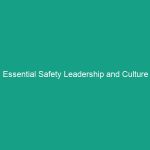Good Morning Team!
Today, we’re going to talk about something that is crucial for our Safety and health on the job: Essential Sling Inspection Guidelines. Sling inspection is a vital part of our operations, and understanding how to do it correctly can help us avoid critical Safety risks that could lead to serious injuries or accidents.
Understanding Sling Inspection Guidelines
The term sling inspection guidelines refers to the Procedures and Standards we must follow to ensure that our lifting slings are safe to use. Slings are essential in lifting and moving heavy materials. If they fail, the consequences can be severe, potentially resulting in accidents, injuries, and even fatalities.
It’s easy to underestimate the importance of inspecting slings. Some might think, “They look fine to me,” but visual inspections alone are not enough. Regular and thorough inspections are necessary to identify wear and tear before it leads to failure.
Key Hazards, Risks, and Safety Considerations
Using slings improperly or failing to inspect them can lead to various Hazards:
- Equipment Failure: Slings that are worn, frayed, or damaged can snap, leading to dropped loads.
- Injuries: Employees nearby may be at risk of being injured by falling loads.
- Property Damage: Dropped loads can also damage equipment or materials.
It’s vital to recognize the real-world consequences of ignoring sling inspections. For instance, there have been cases where a sling’s failure led to serious injuries and significant financial losses for companies.
Best Practices, Procedures, & Actionable Advice
To avoid critical safety risks associated with slings, follow these essential inspection guidelines:
1. Visual Inspection
Start with a visual inspection before each use. Look for:
- Fraying or cuts in the sling material.
- Signs of excessive wear.
- Damaged or missing hardware.
- Twists, kinks, or knots.
2. Regular Thorough Inspections
In addition to visual checks, conduct more thorough inspections at regular intervals. The frequency of these inspections can depend on how often the sling is used. Here are some guidelines:
- Daily for slings used in heavy operations.
- Weekly for slings in moderate use.
- Monthly for slings that are seldom used.
3. Record Keeping
Keep a record of all inspections. Document any findings and actions taken to address issues. This not only helps in maintaining safety but also in complying with Regulations.
4. Training and Awareness
Ensure all employees are trained in sling inspection procedures. Conduct regular safety meetings to keep safety top of mind. Share learning experiences and encourage a culture of safety.
5. Proper Sling Usage
Use slings as intended. Refer to the load capacity and ensure that the sling is appropriate for the load being lifted. Misusing slings can lead to failure.
Real-World Case Study
A construction site experienced a serious incident when a sling that hadn’t been inspected properly failed while lifting a heavy load. The load fell, injuring two workers and damaging equipment. This incident highlighted the importance of following sling inspection guidelines and adhering to Best Practices.
Regulations, Standards, and Compliance
Compliance with safety regulations is non-negotiable. Here are some standards to keep in mind:
- OSHA Standards: The Occupational Safety and Health Administration (osha) has specific regulations regarding lifting devices and slings.
- ANSI/ASME Standards: The American National Standards Institute and the American Society of Mechanical Engineers provide guidelines for sling use and inspection.
Adhering to these regulations is critical. Not only does it protect employees, but it also shields the company from potential legal issues and fines.
Employee Engagement & Discussion
Now, let’s open the floor for discussion. Think about the slings we use every day. Can anyone share a time when you noticed a potential issue with a sling? What steps did you take to rectify it? Engaging in these discussions can help us all learn and improve our safety practices.
Conclusion & Key Takeaways
To wrap up, remember that following essential sling inspection guidelines is crucial in avoiding critical safety risks. Regular inspections, proper usage, and thorough Training can significantly reduce the likelihood of accidents in the workplace.
Key Takeaways:
- Always conduct both visual and thorough inspections.
- Document all inspections and findings.
- Ensure compliance with safety regulations.
- Engage in discussions about safety practices.
Thank you all for your attention and commitment to maintaining a safe work Environment. Let’s prioritize safety and look out for one another.


